A new book by folklorists Michael Fortune and Aileen Lambert features a unique collection of May-related folklore, with a particular focus on the May Bush Tradition in County Wexford - read an extract below.
The duo have been at the forefront of documenting, promoting and celebrating May traditions for the last two decades, and are the driving force behind the May Bush revival in County Wexford.
The first of its kind, The May Bush in County Wexford takes a personal and contemporary look at the May Bush tradition and its connections across Ireland, Europe and North America.
The Coming of Summer
On the first of May summer officially begins in Ireland and, in centuries-old fashion, it's also the time that many people here in Wexford (and will gather their painted egg shells, ribbons and bunches of flowers, to decorate their May Bush.
The May Bush tradition is not just practised in Wexford. It is found in other counties in Leinster, East Munster, East Connaught and Ulster. Wexford, however, is regarded as one of the strongholds of the tradition, particularly in recent decades.

The May Bush is a piece of a whitethorn (known locally as a 'sceach') or a furze/gorse bush, which is erected on May Eve or May Day.In most cases they were decorated with painted egg shells, ribbons and seasonal flowers. Traditionally, May Bushes were erected in a prominent place in a bid to keep the ‘pisheógs’ away (i.e. the fairies/bad luck) and, like so many of our customs, the May Bush was centred on the protection of the growing crops and the milk yield.
Egg shells were kept from Easter Sunday, mostly by girls, and then painted and hung on these bushes. As a child, my late mother used balloons which were bright for a moment, but they didn't last long!Not everyone uses a whitethorn or furze and many people use what tree and shrub they have growing in their garden. Another contemporary take on the eggs these days is the use of plastic Kinder egg shells. These can be spotted on May Bushes around the county. I have also noticed over the past two decades, here in Wexford and also in Offaly, that people use the leftover coloured foil from their chocolate Easter eggs.
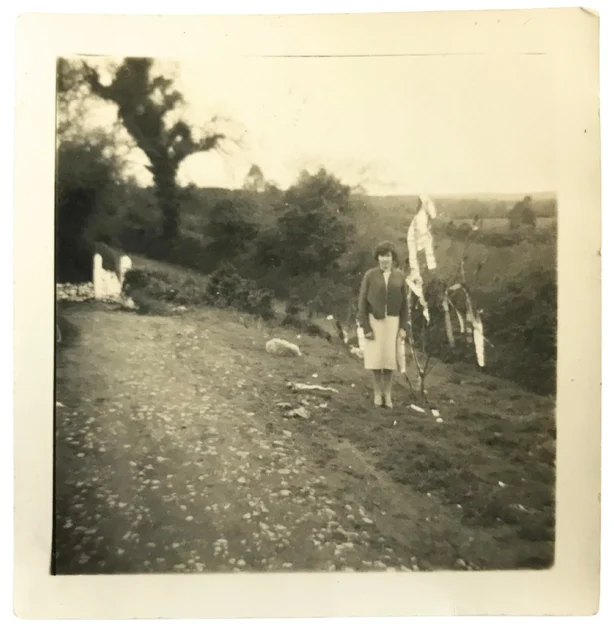
Above is a fantastic image of Kathleen Cullen née Leonard standing by a May Bush at her home in Coolgreany around 1950. Rare to have family photos like this and I was delighted to be sent it by Margaret Nash back in 2019.
The late Elsie Donnolly, from Cottage Row in Taghmon, always included a bit of this foil on her May Bush and you’d even find the cardboard boxes at times. Old Christmas decorations were also used, and I always thought that if someone didn’t know what a May Bush was, and they were passing by, they could easily think someone emptied a recycling bin on a bush by the side of the road! These days, people leave their May Bush up for the month, while in the past it was often left to wither of its own accord. The key thing was to get it up on May Eve/Day, as this was the turning point in the year when "the fairies" were out and it was used to keep them and bad luck away from your home and farmyard.
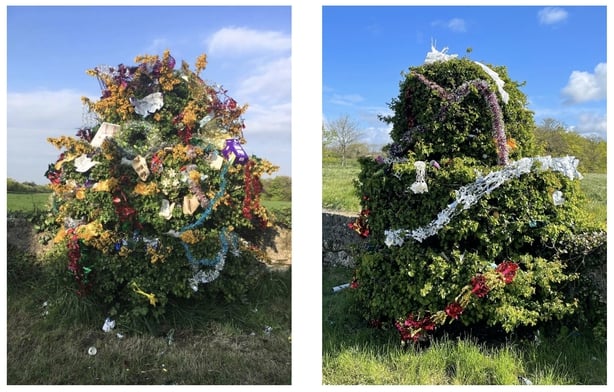
I took the photo below outside Ballymurphy, in south Carlow, on my way home to Wexford in early May 2023. They were taken quickly, as the timing was limited, as I just happened to chance upon the scene.
The picture is of Luke Doran (a man I’d filmed previously) bringing in his cows to be milked. Like so many country farming people, Luke put up a May Bush every year, and had the same story that it would "keep the fairies and bad luck away".

The thing is, the May Bush has to be in a spot where the cows pass, and as you can see it is tied to the tubular farm gate. This is as real as you’ll ever get with the May Bush tradition in Ireland. Also note the flowers had died off the whitethorn but on May Eve they would have been in bloom, and this was crucial. Nothing staged, or re-interpreted, or new-agey here - this is rural real.
On leaving Luke, I called on his neighbour Peggie Foley, and she too had a little May Bush stuck at her gate. She also uses whitethorn, and told me they always had to include five bunches of flowers on it, a custom tied in with the Rosary.
May Day Celebrations Across Europe
Putting up and decorating a May Bush was part of a wider European May Day celebration, marking the start of summer.
The May Bush is, without doubt, related to the May Pole tradition that you still find in parts of Germany, Sweden, England, Wales, France and northern Spain. In fact, in parts of Clare and Galway, many older people referred to the sprig of furze or rowan that they'd stick up on May Eve as "The May Pole".
This confusion is interesting, as in some parts of Ireland there were actual May Poles, like you'd find in England and Germany. However, many of May Pole accounts that you'd read in the Schools' Folklore Collection, for example, are actually referring to May Bushes, May Boughs and May Trees.
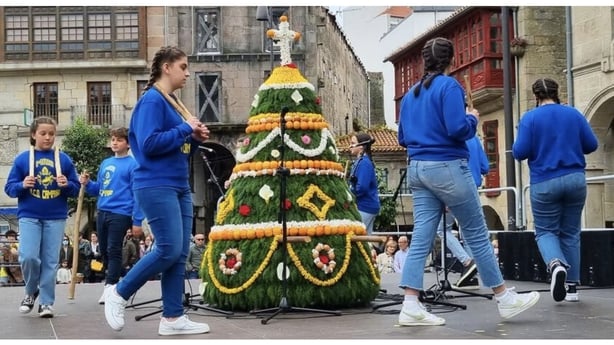
I found the closest connection to our May Bush tradition is in Galicia, in north west Spain. Many villages there celebrate Fiesta de los Mayos on the 1st of May, and one of the central practices is decorating a May Tree. The tree has the same aesthetic features as some of our furze bushes, while they also mark the day with music, song and dance.
What is also really striking is that across northern Spain and the Basque Country, they have similar costumed dancers/performers like our Wexford mummers who perform at these May Tree and May Pole events. Our mumming tradition in Wexford originates in the west country of England and Cornwall but I think there are wider maritime connections between England, Cornwall and northern Spain which reveal themselves here.
As you can see, there is uniformity to the clothes worn, but the wooden swords/sticks which are raised, swung and banged are identical.
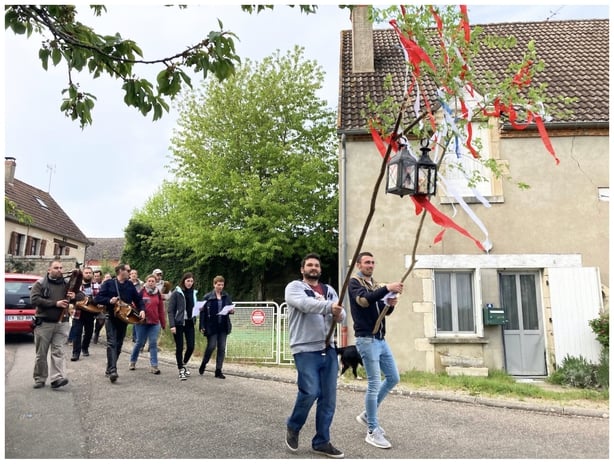
Here are photos from the evening of April 30th 2023, from Château-sur-Allier in France. They have a similar tradition of decorating a freshly cut down bough of a tree and decorating it with ribbons and lanterns. They parade these through the village, going from house to house playing tunes and singing songs.
May Pole Tradition in England, Wales, Germany and Sweden
Our nearest neighbours in England and Wales still have a strong tradition where they erect a May Pole on the 1st of May and also crown a May Queen. This May Pole ritual is also done in Sweden, and in pockets of Germany, to this day. In fact, the tradition is on the rise in Germany and many villages are reinstating their May Poles. These poles are enormous affairs, and are erected often with a tree or boughs on top, with a garland of green, and raised towards the heavens.
This May Pole tradition was also found in towns in Ireland, and still is done in some, most notably in Holywood in Co. Down, where they have big May Day celebrations to this day.
The May Bush in Newfoundland
The tradition of the May Bush/Tree was brought out to Newfoundland by the south eastern Irish who came over in the late 1700s/early 1800s. To this day, some of the older people decorate a tree with blue ribbons for the 1st of May.
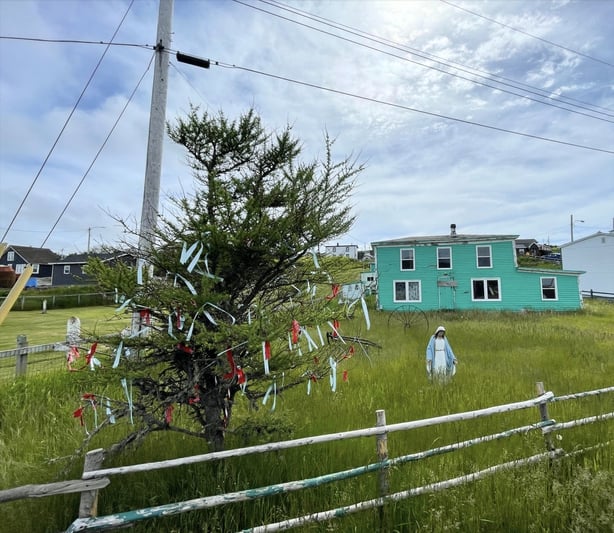
This May Tree in the photo was beside where we stayed on a visit there in 2019. It had blue ribbons on it and a statue of the Virgin Mary to the side: blue being the colour related to Mary and the month of May. Come the 1st of June, the blue ribbons are taken down and red ones put up instead, and the May Tree becomes a June Tree. The red colour is related to the Sacred Heart which is associated with the month of June. Conway, in Point Lance, does this every year too but she uses a smaller tree.
Brooms and Witches
There is an awful lot of our May folklore based around a type of witch that would come and steal your milk or take your profit. In our Irish folklore this witch appears on May Eve and May Day when we are transitioning from Spring into Summer.
The 1st of May was seen by many as the start of the new year in Ireland and we grew up with the story/belief of not giving away anything on the 1st of May, as you'd be giving away your luck or your profit for the rest of the year.
My late mother, Ann Fortune, swore by this and so did her neighbours. Under no circumstance would the farmers sell milk that day as they believed they’d be "giving away their luck/profit for the year".
In May there was so much invested in the protection of animals, milk and the crops that people had, and as pointed out already, there would be a string of rituals/customs to keep evil and "the fairies" at bay. These ranged from erecting the May Bush, to blessing the stock and the land with water or driving cattle through fires etc. However, one of the most sinister threats came in the form of an old hag/witch who would sneak onto your land, go to your well and repeatedly skim it with a saucer or her hand in a bid to take your profit.
When I say this, I'm not talking 19th century Ireland, I've accounts from people in the past twenty years remembering this, including my own father and grandmother in Ballygarrett. The story goes that on the morning of the 1st of May, you'd go to your well and when you'd get there you'd find this old woman or hag skimming it and repeating lines such as "Half for you, half for me" or "All the profit from this townsland onto me". And by doing so, she is taking the best spring water from the well, the cream from the milk etc. In April 2016 I recorded Jim Deane of Tinryland relate a story he had where the old hag/witch has been removed and a scissors/knife cutting a stream has replaced the saucer in the well.
But most importantly there has been a shift in power and the onus has now been put on the individual and they had to do the cutting of the water. Jim told me that you’d have to do it first thing in the morning before you’d speak to anyone and when cutting the water you would repeat this verse "All come hither to me, this fine May morning". He said this was a bit of a "50/50" as you could wish bad luck on your neighbours, which was a dangerous thing to do while if you "wished good luck on yourself", it also had a throwback as while you might gain in one way, you will lose in another.
These accounts of "skimming the well" are found around the country and I have recorded various accounts in Offaly and Tipperary over the years. I have also heard accounts in Tipperary of people running a bed sheet through a gap in a ditch on a May morning to soak up the dew on the grass. As odd as it may sound, the gap was the entry point into the field and associated with luck coming in and out.
Hares Stealing Milk
As stated, many people put up the May Bush to keep the fairies from stealing their milk profit and yield. There is an abundance of stories in our folklore of shape-shifting hares seen on a May morning, sucking the milk from the cows or an old woman milking your cow who would turn into a hare when confronted. The classic story goes that the owner of the cow would go out into the field and find the hare at work. He would shoot at it, but only wounding it; and it would then run bleeding into a nearby house. The farmer would call to the door of the house and an old woman would appear, bleeding from the hip...
The May Bush in County Wexford is out now - find out more here.
Disclaimer: The copyright of this article belongs to the original author. Reposting this article is solely for the purpose of information dissemination and does not constitute any investment advice. If there is any infringement, please contact us immediately. We will make corrections or deletions as necessary. Thank you.






